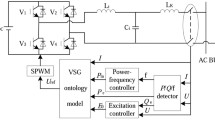Abstract
As an important part of electric multiple units (EMU), the auxiliary power supply system plays an important role in the normal operation of the vehicle. In order to improve the reliability of the auxiliary power supply system, the virtual synchronous generator (VSG) technology is applied to the parallel control system of auxiliary inverter. The essence of VSG technology is to control the inverter to simulate the working principle of synchronous generator, so as to obtain similar operation characteristics of synchronous generator. The auxiliary inverter controlled by VSG technology can avoid the disadvantage of hard external characteristics of power electronic devices. Its rotating inertia can obviously prevent frequency fluctuation, and the system has high stability and reliability. In this paper, the frequency and voltage of the auxiliary inverters are controlled independently with VSG technology, so that the output voltage can be controlled stably and the power quality can be improved. Finally, the MATLAB simulation results show that the parallel control of auxiliary inverter based on VSG achieves the expected goals.
Access this chapter
Tax calculation will be finalised at checkout
Purchases are for personal use only
Similar content being viewed by others
References
Wu D, Guo Z, Sha D et al (2012) Parallel-connected three-phase inverters for railway auxiliary power supply without sensing output currents. In: The twenty-seventh annual IEEE applied power electronics conference and exposition (APEC), pp 136–140
Jie C, Huiqing D, Lei W et al (2015) Parallel control strategy for auxiliary systems with complex load characteristics. Proc CSEE 35:213–219 (in Chinese)
Jie C, Mingwa L, Xin C et al (2018) Wireless parallel connection and circulation suppression technology of inverters based on droop control. Trans China Electro-Tech Soc 33(07):1450–1460 (in Chinese)
Sakimoto K, Miura Y, Ise T (2011) Stabilization of a power system with a distributed generator by a Virtual Synchronous Generator function. In: 2011 IEEE 8th international conference on power electronics and ECCE Asia (ICPE & ECCE). IEEE, pp 1498–1505
Liu J, Miura Y, Bevrani H et al (2016) Enhanced virtual synchronous generator control for parallel inverters in Microgrids. IEEE Trans Smart Grid, 1–10
He J, Li YW (2011) Analysis, design, and implementation of virtual impedance for power electronics interfaced distributed generation. Ind Appl IEEE Trans On 47(6):2525–2538
Chen Y, Smedley K (2005) Parallel operation of one-cycle controlled grid connected three-phase inverters. In: Fourtieth IAS annual meeting. Conference record of the 2005. Industry applications conference, 2005, vol 1. IEEE, pp 591–598
Li Z, Li Y, Wang P et al (2008) Three-phase PWM inverters with three-phase output transformer and three-phase filter inductor. In: International conference on electrical machines and systems, 2008. ICEMS 2008. IEEE, pp 1116–1121
Guerrero JM, Vasquez JC, Matas J et al (2009) Control strategy for flexible microgrid based on parallel line-interactive UPS system. IEEE Trans Ind Electron 56(3):726–736
Zhong QC, Nguyen PL, Ma Z et al (2014) Self-synchronized Synchronverters: inverters Without a Dedicated Synchronization Unit. IEEE Trans Power Electron 29(2):617–630
Wang W, Zhu Y (2011) The space vector PWM scheme for a novel three-level inverter with two parallel three-phase full-bridges. In: 2011 International conference on electrical and control engineering (ICECE). IEEE, pp 903–906
Garralda D, Marroyo L, Gubia E (2014) A method for modelling the power flow in train auxiliaries fed by two inverters set in parallel. In: 2014 17th IEEE mediterranean electrotechnical conference (MELECON). IEEE, pp 115–121
Acknowledgements
This work is supported by the National Key Research and Development Program (2016YFB1200502-04).
Author information
Authors and Affiliations
Corresponding author
Editor information
Editors and Affiliations
Rights and permissions
Copyright information
© 2020 Springer Nature Singapore Pte Ltd.
About this paper
Cite this paper
Lu, L., Li, X., Kuang, Y., Chen, J., Qiu, R. (2020). Parallel Control of Auxiliary Inverter Based on Virtual Synchronous Generator. In: Jia, L., Qin, Y., Liu, B., Liu, Z., Diao, L., An, M. (eds) Proceedings of the 4th International Conference on Electrical and Information Technologies for Rail Transportation (EITRT) 2019. EITRT 2019. Lecture Notes in Electrical Engineering, vol 638. Springer, Singapore. https://doi.org/10.1007/978-981-15-2862-0_11
Download citation
DOI: https://doi.org/10.1007/978-981-15-2862-0_11
Published:
Publisher Name: Springer, Singapore
Print ISBN: 978-981-15-2861-3
Online ISBN: 978-981-15-2862-0
eBook Packages: EngineeringEngineering (R0)




